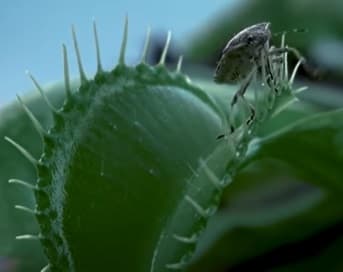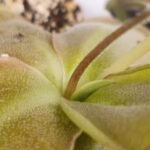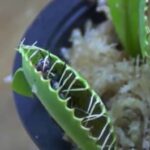As an Amazon Associate, this site earns commissions from qualifying purchases. For more details, click here.
Did your Venus flytrap suddenly stop making traps? Does it no longer replace old traps with new ones? In this article I will go through the reasons why this is happening and the solutions.
A dormant Venus flytrap is not going to produce any traps. If the plant isn’t dormant but has no traps, it is not receiving enough sunlight.
How to Make Venus Flytraps Create Traps
I want to point out that it’s normal for some Venus flytrap leaves not to have traps. This does happen and is nothing to worry about. If the plant is entering dormancy, it’s also normal for it to stop producing traps.
But if your Venus flytrap isn’t dormant and produces few or no traps, it needs more light. I will show you how to improve lighting for your plant here.
Bring Venus Flytraps Outdoors
Venus flytraps need at least 6-12 hours of light to make traps. The simplest solution is to move the plant outdoors so it can receive more sunlight.
Venus flytraps grow best in direct light. It will still thrive in partial shade provided there is 6-12 hours of light available.
Before moving a Venus flytrap outdoors, look for a spot that gets a lot of light and without any shade. While these plants can grow in shade, direct light is better.
One thing to keep in mind is that Venus flytraps require light, not heat. Place the plant under shade if the temperature exceeds 95 F for extended periods.
If the plant gets plenty of light but looks pale, it could be due to lack of water. This can be a problem especially with high temperatures in the 90s. If you are using the tray method, make sure the water gets replenished regularly.

Place on a Windowsill
Another option is to place your Venus flytrap on a windowsill. You can raise these plants indoors provided there is sufficient light.
This is as easy as carrying the plant and placing it on a windowsill. You can choose any window as long as it gets at least 6 hours of sunlight.
If you don’t have a garden but still want to grow Venus flytraps, this is a good option. But there is another method you can try if your area doesn’t get sufficient natural light.
Do Venus Flytraps Grow with Artificial Lighting?
You can use artificial lights if natural light is limited. LED lights and T8 lights work well.
Personally I use 50W LED lights from Barrina because they are cheap but efficient. I have grown Venus flytraps outdoors in natural light and indoors with these LED lights and they’re both going strong.
You can also use Barrina T8 lights as Venus flytraps respond well to them too. Either of those is fine.
A few things to keep in mind about indoor grow lights.
- Introduce artificial light to Venus flytraps slowly. Start with an hour per day and increase gradually.
- Keep the light at least 6 inches away from the plant.
- Use only LED lights with cool colors to avoid excess heat.
You only need to use indoor grow lights if natural light is limited. You can however, use artificial lighting as a supplement to outdoor light.
How Lighting Helps Venus Flytraps Grow Traps
Like other plants, Venus flytraps use light for photosynthesis. They get energy from light (natural or artificial) and use it to create traps.
These traps lure insects which provide Venus flytraps with nutrients to boost their immune system. Without enough light, these plants lack the resources needed to create traps.
While Venus flytraps without traps looks alarming, the solution is easy. Just provide more light and you should see traps grow.
It takes a week or two for these plants to create new leaves and traps. It might take more time – or less – depending on how healthy the plant is. Some cultivars adjust faster than others to new environments so it depends.
One thing you can be sure of is that healthy Venus flytraps will always have traps. Most have 4-8 traps simultaneously, but large, healthy ones can have as many as 20 traps at once.
Do Venus Flytraps Need Traps to Live?
Venus flytraps can survive for long periods without eating insects. If the plant gets plenty of light, it will survive without traps.
Contrary to popular belief, insects are not food for Venus flytraps. Venus flytraps make food through photosynthesis just like other plants.
Venus flytraps trap and eat bugs for their nutrients. Carnivorous plants grow in poor soil so they have to get nutrients through other means.
Insects have nutrients similar to those found in nutrient-rich soil, so carnivorous plants like Venus flytraps developed traps to take advantage.
While Venus flytraps can have several traps, each one has a limited number of times it can shut. This is where the Venus flytrap’s ability to count becomes very useful.
Venus flytraps only activate the trap when its sensors are triggered twice in under 30 seconds. It then waits for three more stimuli before releasing its digestive enzymes.
My Venus Flytrap Has No Traps: Dormant or Not?
Venus flytraps grow in spring and summer and start to go dormant in fall and winter. The plant grows again in spring.
As a Venus flytrap starts to enter dormancy, growth slows down. Its leaves drop and the remaining turn black.
First time Venus flytrap owners often mistakenly assume the plant has died. But if you bought a Venus flytrap in the fall or late summer, expect it to go dormant soon.
If traps start to disappear or die off, that’s normal. I want to add that dormant Venus flytraps still require lots of light and a bit of water.
Venus flytraps can stay dormant for 4-5 months. During this time, don’t expect any traps to grow.
For a first time owner this can be a frustrating experience. I understand especially if you want to watch a Venus flytrap catch and eat bugs.
But dormancy is essential for Venus flytraps. Without it the plant cannot survive. Once the plant starts regrow in spring, it will start making traps again.
Related Questions
My Venus flytrap is no longer growing any leaves or traps. Why?
The plant isn’t getting enough light. Venus flytraps need 6-12 hours of light and sufficient water. Venus flytraps can grow in partial shade, but full light is better if the plant looks pale.
Lack of light is also the reason why a Venus flytrap may have leaves but no traps. They lack the resources necessary to make the traps.
Why are all my Venus flytraps shedding their traps and look sick?
It’s either not getting enough light or is dormant. Venus flytraps go dormant in winter and it’s normal for them not to produce traps during this period. If it isn’t winter, the plant is suffering from lack of light.
Why are there only a few traps on my Venus flytrap?
A typical Venus flytrap has 4-8 traps. Having only 4-5 traps is fine for most variants.
If your Venus flytrap used to have a lot of traps but now makes less, something in its environment has changed. Is it still getting direct light?
if the plant is outside, check if something is blocking its access to light. Do the same if you grow Venus flytraps on windows.
How can I make Venus flytraps make more traps?
The single most important thing you can do is make certain the plant receives 6-12 hours of light every day. It can be natural, artificial or a combination of both.
Venus flytraps also need moist soil so water is essential. Do not use tap water as it contains minerals that are harmful to the plant. Use rainwater or distilled water instead.
Will feeding more often help Venus flytraps grow more traps?
No. Overfeeding can actually kill the traps. Indoor Venus flytraps can be fed once a week. If the plant is outside, it will have access to all the bugs it needs and doesn’t have to be hand fed.

My fascination with carnivorous plants began many, many years ago with Venus Fly Traps. Now I am more than happy to impart what I know with other enthusiasts and those who are curious about meat eating plants.


